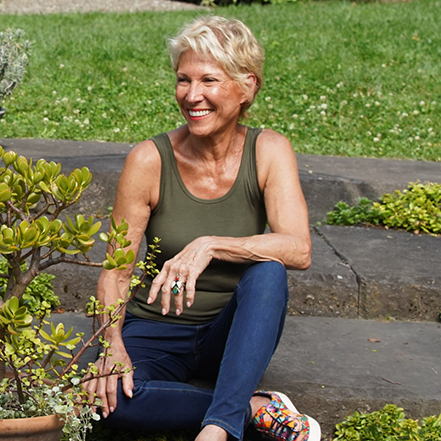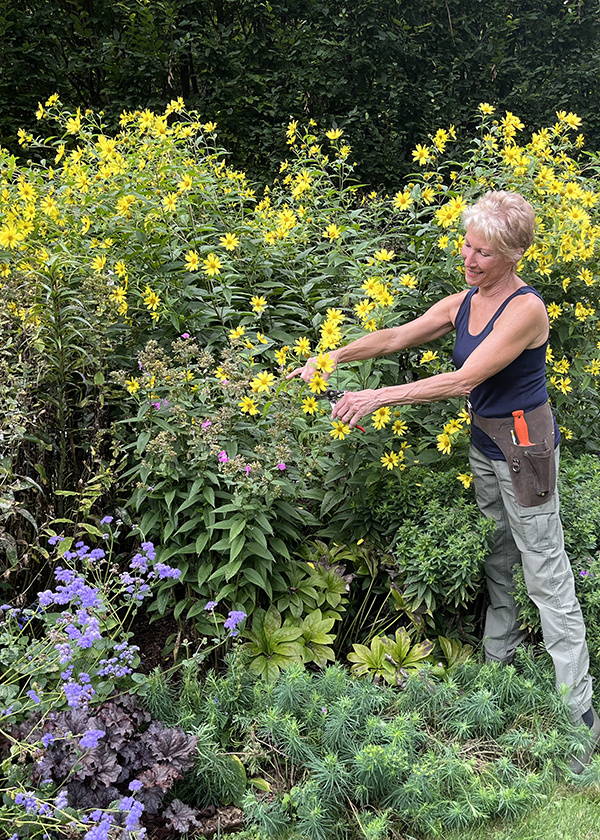After discovering how proper body movement could alleviate aches and pains while gardening, Madeline Hooper, the creator and host of GardenFit, made it her life's work to spread the word.
We had a delightful chat with Madeline to discuss how we can better move and align our bodies to take the body stress out of gardening, thus being able to garden even more. Madeline explains that "many of us have never thought of body alignment in our life, but once we do, it changes everything."
As you read through Madeline's top 5 tips for healthy movement in the garden, you'll notice that the secret is quite simple and easy to achieve by learning some body awareness techniques. This new body awareness will help prevent the common aches and pains that many of us have come to accept as part of gardening. Madeline also shares a bonus tip for how to recover quickly after a day working in the garden.
What is GardenFit?
GardenFit is a TV show (now streaming on PBS) that is centered on the belief that gardening should be a joy, not a chore. This series blends captivating garden tours with practical self-care advice, guiding viewers on nurturing their bodies as they tend to their gardens.
Sponsored by Monrovia, Season 2 is special because Madeline joins fitness instructor, Adam Schersten, to visit artists across the nation and teach them how to move in a more mindful, healthy way in their gardens. Plus, they discover all of the joyful and intriguing ways that gardens impact art along the way.
We've teamed up with GardenFit because, at Monrovia, we strive to do everything well, including the way our craftsmen move when we are lifting, bending, and working with plants. We stretch together every day before we begin our work at the nursery. We don't just care about choosing the best varieties to grow, we also grow them well by taking care of our craftsmen. We believe gardeners should learn how to grow beautifully in the garden too—taking care of their form so they can keep gardening for many years to come.
GardenFit's Top 5 Tips for Healthy Movement in the Garden
1. Squat to Lift
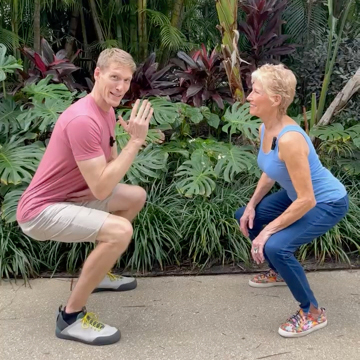
The main thing you want to avoid is lifting using your back. It's important to lift using your legs and your whole body. The position of a squat is essential when it comes to lifting properly. It doesn't matter how low you can squat today. Start where your body is today and work from there!
How to squat to lift in the garden (or anywhere!):
- Keep your back as straight as possible—try tucking your tailbone a bit to keep your back aligned.
- Bend your knees and squat down as far as you can.
- Get a grip on the plant, or whatever it is you are moving.
- Rise back up by pushing with your legs, keeping your back straight.
- If you're moving the plant somewhere, pull the plant into your body and use your body to brace the plant.
- Use the same squat position to put it down.
If you're carrying a plant or something tall, you can still squat without bending over, keep your chest up and back straight as you squat down to put it down. Watch the short video above on YouTube to see the full movement.
2. Protect Your Shoulders When Reaching High
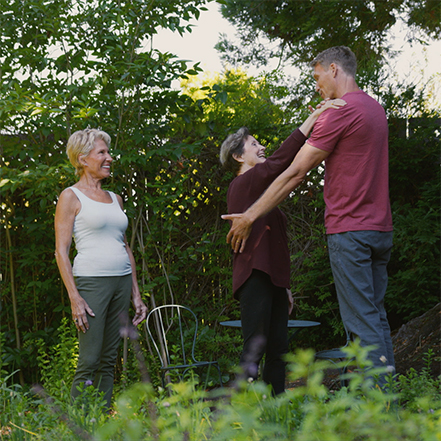
Consider your body's alignment when reaching high to prune, place a pot, grab something out of your shed, or do anything that requires you to reach upwards for something. Most people raise their shoulders when they are reaching up, which stresses their neck and shoulders.
A slight change in how you align your body and move your arms and shoulders will take the tension out of your neck and shoulders. Reaching high properly is just a simple two-step process, but it's often a big change in movement that can make a big impact in how your body feels after a day of pruning.
How to reach high while protecting your shoulders and neck:
- Stand up straight and let your shoulder blades slip down your back. This engages your upper back muscles to keep your shoulders down rather than letting them raise up and pinch your neck.
- Practice raising your arms while keeping your shoulders down. This allows your arms to lift, but not your shoulders.
Watch episode 3, "Edible Classroom" with Alice Waters of Chez Panisse to see the full movement.
3. Rotate Your Elbows in While Pruning
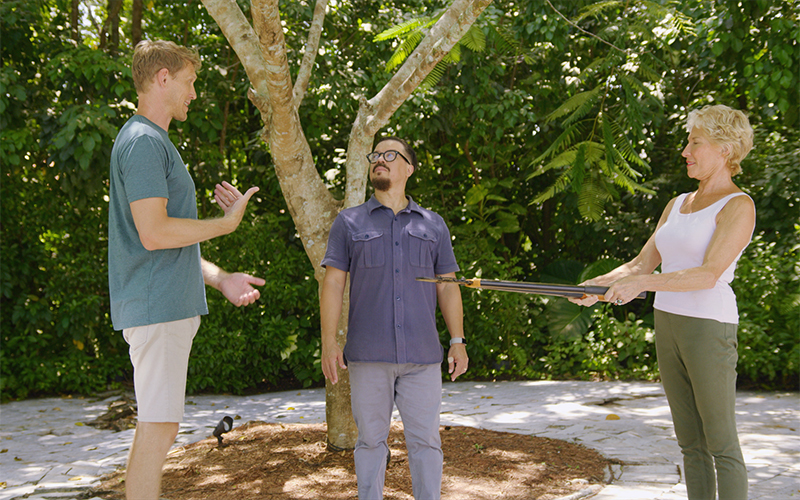
Try this to experience a difference in how your body feels with a slight change: First, bend your arms and move your elbows out away from your body. Now, move your elbows in towards your body and rotate your palms up. Can you feel how this opens up your chest and allows you to stand taller?
We tend to clip and prune with our elbows out and palms down. This hunches our upper back and stresses our neck and shoulders. Try the following instead.
How to rotate your arms while pruning:
- Once again, stand straight with your shoulders down and back.
- Hold your elbows in close to your body by rotating them in.
- Move your hands or wrists to prune, not your elbows.
Watch episode 7, "Painting with Nature" with Jose Alvarez (D.O.P.A.) to see the full movement.
4. Check Your Alignment When You Get Up
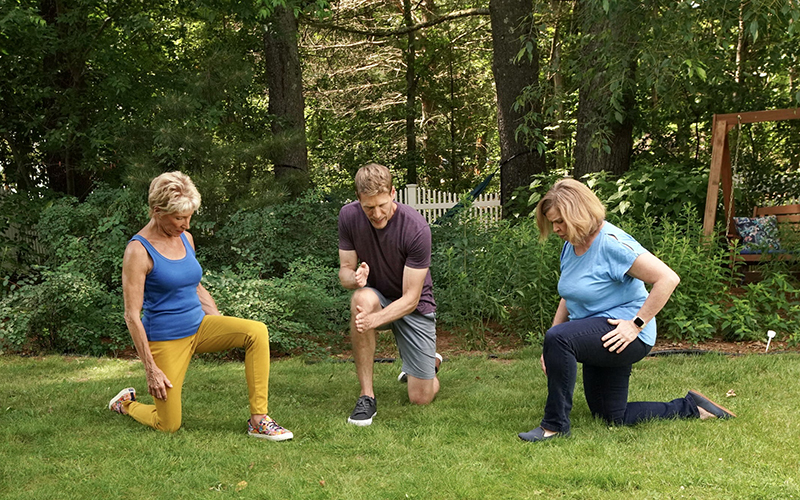
If you're working close to the ground, which all of us gardeners have to do, you're probably working on your knees. You'll need to plant one leg in order to stand up, and this is where body alignment is incredibly important.
Standing up correctly requires awareness of the alignment of your thigh to your foot. Many of us stand up with our hips out or our toes pointing in different directions. This misalignment throws the body off immediately. Instead, make sure your hips, legs, and feet are in alignment before you push to stand up.
How to stand up after working on the ground:
- While on your knees, raise one foot and plant it on the ground directly underneath the knee.
- Align your thigh and your foot so they are pointing in the same direction.
- Press up from your foot into standing.
See more by watching episode 8, "A Symphony of Native Plants" with Cynthia Meyers to see the full movement (airing May 6, 2024).
5. Use Your Palm and Fingers, Not Your Thumb When Clipping
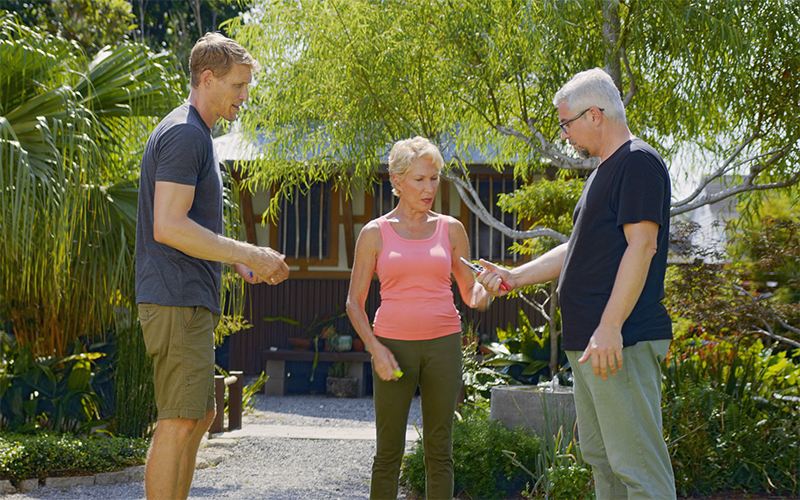
This one is also a very simple change for a movement that typically causes so many people pain. Many people clip using their thumb joint and muscles to do most of the work. This causes a lot of pain in the thumb. Here's how to use your clippers to avoid thumb pain and discomfort.
How to protect your thumb while clipping:
- Place the handle of the clippers in the middle of the palm, instead of near your thumb joint.
- Only use the fingers to squeeze to clip, not the thumb.
Bonus tip: Build your ambidexterity in the garden. Switch between hands when you're clipping and weeding, switch the foot you're using to push your shovel into the ground, etc. Building strength and balance on both sides of your body will protect you from overuse injuries down the road.
See more by watching episode 10 "Plants and All That Jazz," with Leslie Martin for the full movement (airing May 20, 2024).
Recovery Bonus: Reset the Spine to Recover From Bending
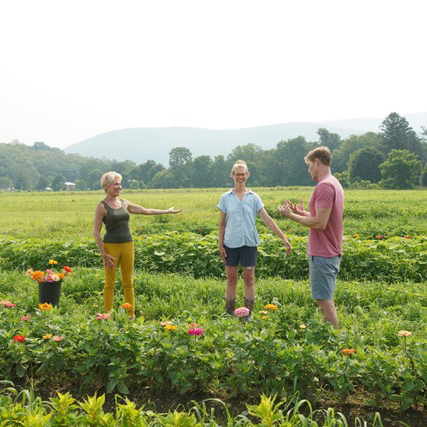
If you're bending over to deadhead plants, prune, or plant, it's important to do a counter stretch as soon as you're done to relieve the tension that may have built in your back. Here's a simple move to reset and recover from bending in the garden.
How to reset your spine after bending in the garden:
- Stand up straight.
- Raise one arm up and out to your side.
- Turn the palm of that hand so it's facing up.
- Keep the hips pointing forward while you move the arm back behind you and twist your torso.
- Turn your head to follow your arm and look in the same direction as your hand.
- Return to neutral
- Repeat with the other arm.
Watch episode 5, "Field of Dreams," with Jenny Elliot of Tiny Hearts Farm to see the full exercise.
Looking for more details on how to take better care of your body while taking care of your garden? Watch GardenFit Season 2 to learn more about how to move in the garden so you can keep gardening without aches and pains for many more years to come.
About the Show
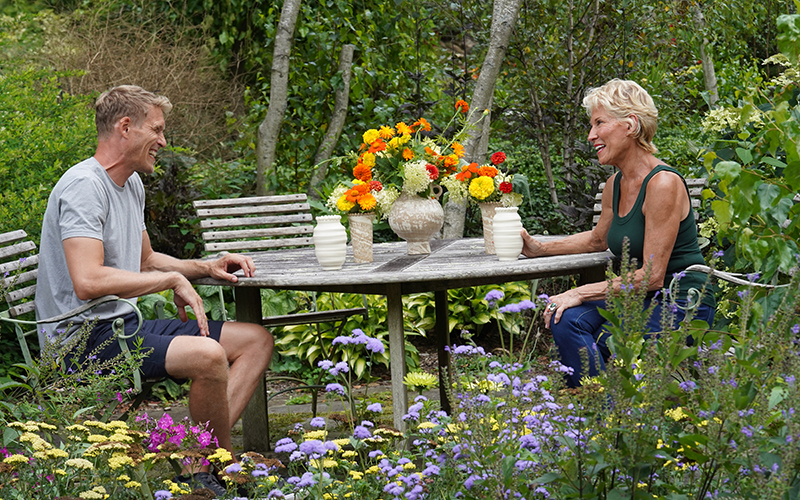
GardenFit takes a new approach to gardening healthy, based on the premise that gardening should be joyful, not painful. It teaches viewers how to take care of their bodies while taking care of their gardens. Season 2 brings 13 new episodes featuring well-known artists who are also passionate gardeners.
GardenFit creator, host, and expert gardener Madeline Hooper is joined by fitness instructor Adam Schersten as they visit unique artists, see how their art is inspired by nature, and help them get GardenFit!
About Madeline Hooper
After pioneering a successful public relations career at DeVries Global and later a career in ballroom dance, Madeline de Vries Hooper shifted her focus to gardening. For the past decade, she's served as Vice Chair of the Berkshire Botanical Garden, exploring gardens across the US and Europe and connecting with top horticulturalists and designers. Despite her passion, gardening led to discomfort until a personal trainer introduced her to pain-relieving techniques. Inspired, she created the GardenFit TV show and workshops. Based in Columbia County, New York, Madeline and her husband have nurtured RocklandFarm, a 10-acre garden, for three decades.
